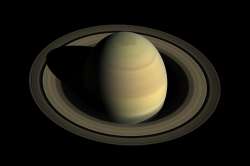Scientists finally find answer to the 'Saturn' mystery, know what time it is on the Ring Planet | DEETS INSIDE
It was a mystery that eluded scientists and astronomers for decades, because the Saturn planet has no solid surface with landmarks to track as it rotates.

Thanks to NASA's Cassini spacecraft, reserachers believe that they have solved a longstanding mystery of solar system science: the length of a day on Saturn i.e, 10 hours, 33 minutes and 33 seconds.
It was a mystery that eluded scientists and astronomers for decades, because the Saturn planet has no solid surface with landmarks to track as it rotates. The planet also has an unusual magnetic field that hides the planet's rotation rate.
Scientists said that the secret was hidden in the planet's rings.
During Cassini's orbits of Saturn, instruments examined the icy, rocky rings in unprecedented detail. Christopher Mankovich, a graduate student in astronomy and astrophysics at University of California, Santa Cruz, used the data to study wave patterns within the rings.
His work determined that the rings respond to vibrations within the planet itself, acting similarly to the seismometers used to measure movement caused by earthquakes. The inside of Saturn vibrates at frequencies that cause variations in its gravitational field. The rings, in turn, detect those movements in the field.
Mankovich's research published in the Astrophysical Journal, describes how he developed models of Saturn's internal structure that would match the rings' waves. That allowed him to track the movements of the interior of the planet – and thus, its rotation.
The rotation rate of 10:33:38 that the analysis yielded is several minutes faster than previous estimates in 1981, which were based on radio signals from NASA's Voyager spacecraft.
The Voyager data, which estimated the day to be 10:39:23, was based on magnetic field information. Cassini used magnetic field data, too, but earlier estimates ranged from 10:36 all the way to 10:48.
Cassini's mission ended in September 2017, when, low on fuel, it was deliberately plunged into Saturn's atmosphere by the mission team, which wanted to avoid crashing the craft onto the planet's moons, contaminating them.
The Cassini-Huygens mission is a cooperative project of NASA, ESA (European Space Agency) and the Italian Space Agency. NASA's Jet Propulsion Laboratory, a division of Caltech in Pasadena, manages the mission for NASA's Science Mission Directorate, Washington. JPL designed, developed and assembled the Cassini orbiter. The radar instrument was built by JPL and the Italian Space Agency, working with team members from the U.S. and several European countries.